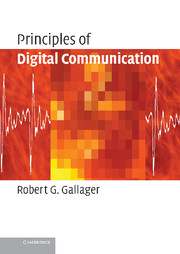Book contents
- Frontmatter
- Contents
- Preface
- Acknowledgements
- 1 Introduction to digital communication
- 2 Coding for discrete sources
- 3 Quantization
- 4 Source and channel waveforms
- 5 Vector spaces and signal space
- 6 Channels, modulation, and demodulation
- 7 Random processes and noise
- 8 Detection, coding, and decoding
- 9 Wireless digital communication
- References
- Index
5 - Vector spaces and signal space
Published online by Cambridge University Press: 05 June 2012
- Frontmatter
- Contents
- Preface
- Acknowledgements
- 1 Introduction to digital communication
- 2 Coding for discrete sources
- 3 Quantization
- 4 Source and channel waveforms
- 5 Vector spaces and signal space
- 6 Channels, modulation, and demodulation
- 7 Random processes and noise
- 8 Detection, coding, and decoding
- 9 Wireless digital communication
- References
- Index
Summary
In Chapter 4, we showed that any ℒ2 function u(t) can be expanded in various orthogonal expansions, using such sets of orthogonal functions as the T-spaced truncated sinusoids or the sinc-weighted sinusoids. Thus u(t) may be specified (up to ℒ2-equivalence) by a countably infinite sequence such as {uk,m; −∞ < k, m < ∞} of coefficients in such an expansion.
In engineering, n-tuples of numbers are often referred to as vectors, and the use of vector notation is very helpful in manipulating these n-tuples. The collection of n-tuples of real numbers is called ℝn and that of complex numbers ℂn. It turns out that the most important properties of these n-tuples also apply to countably infinite sequences of real or complex numbers. It should not be surprising, after the results of the previous chapters, that these properties also apply to ℒ2 waveforms.
A vector space is essentially a collection of objects (such as the collection of real n-tuples) along with a set of rules for manipulating those objects. There is a set of axioms describing precisely how these objects and rules work. Any properties that follow from those axioms must then apply to any vector space, i.e. any set of objects satisfying those axioms. These axioms are satisfied by ℝn and ℂn, and we will soon see that they are also satisfied by the class of countable sequences and the class of ℒ2 waveforms.
- Type
- Chapter
- Information
- Principles of Digital Communication , pp. 153 - 180Publisher: Cambridge University PressPrint publication year: 2008



